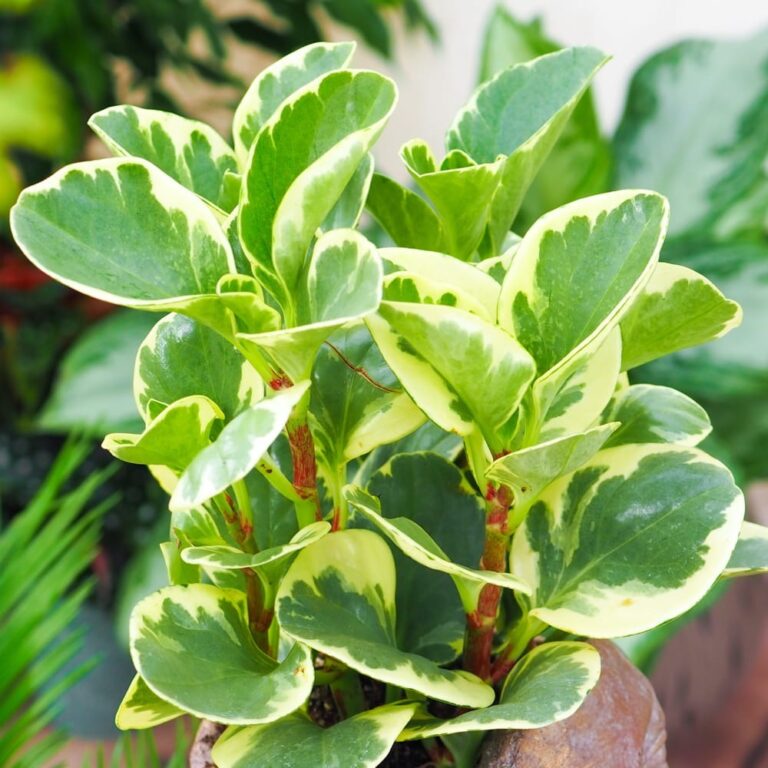Meet the delightful Peperomia, a petite plant with a big personality that effortlessly adds a touch of green to any space. This botanical gem Peperomia, belongs to a diverse family of flowering plants (Piperaceae) native to tropical and subtropical regions. With its vibrant foliage and unique textures, the Peperomia stands out among houseplants, captivating both experienced gardeners and newcomers alike.
They come in various shapes, sizes, and colors, ranging from heart-shaped leaves to compact bushy forms. Their waxy, glossy, or velvety leaves showcase an array of patterns, including stripes, marbling, and intriguing textures. Despite their stunning diversity, Peperomias share one common trait: they are remarkably adaptable and low-maintenance, making them a perfect choice for plant enthusiasts of all skill levels.
Whether you’re a busy urban dweller or a green-thumb aficionado, the Peperomia is a delightful companion that brings a touch of nature’s beauty right into your home.
Care
If we need to sum it up, just don’t put it in direct sunlight, use well-draining potting soil, and do not overwater it. Not very difficult (just like Rosemary or Elephant Ears), but if you are a beginner gardener, pay attention to these aspects:
- Soil: For optimal growth, select a soil blend that replicates the loose, acidic conditions of their natural habitat, such as an orchid potting mix, adding peat moss or vermiculite if desired.
- Water: To maintain healthy growth, it’s important to let the soil dry out between waterings, as these plants have succulent leaves and thrive with less frequent watering to prevent root rot.
- Temperature: Keep your plant in a temperature range of 60-80°F, avoiding temperatures below 50°F, and provide it with diluted general-purpose fertilizer twice a year for optimal care.
- Light: To keep your Peperomia thriving, place it in a well-lit area, preferably near a north- or east-facing window, while avoiding direct sunlight that can harm its leaves.
Propagation
Peperomia plants can be propagated by stem cuttings in spring. Cut off a leaf with an inch of stem and place it in a pot with potting soil, providing indirect light and a mini-greenhouse environment with plastic wrap. Water consistently until roots form, then transplant. For growing from seed, use a soilless mix, keep it moist until germination, and transfer seedlings to a container in a bright spot with indirect sun.
Common Pests
Pruning
Pruning Peperomia plants is an exciting endeavor for avid gardeners, offering numerous benefits such as removing wilted parts, making room for new growth, and promoting overall plant health.
- Prepare the necessary tools: sharp pruners or shears for precise cuts, plant-safe disinfectant and cotton balls to cleanse the plant, and gardening gloves for protection against slips and thorny stems.
- Choose the right time: Consider the ideal time to prune your Peperomia. Avoid winter and fall when the plant is at its weakest. Instead, opt for spring and summer when warm weather ensures a healthy and sturdy plant for pruning.
- Identify targeted areas: Thoroughly examine your plant, marking the sections you wish to prune. Take care not to remove too many leaves, ensuring ample foliage remains for future growth.
- Prune your plant: Using your trusty pruners, begin making swift and seamless cuts at the marked spots. Take breaks to step back and assess your progress. Remember, a single, clean cut is ideal to prevent damage to the Peperomia stems.
Frequently Asked Questions
Generally, watering Peperomias every 10 -12 days is enough. It is important to always check the soil and make sure it is dry before giving it water.
Do peperomia plants need sun?
Peperomia plants thrive in bright, indirect sunlight, making east or west-facing window sills ideal throughout the year, but be cautious of excessive direct sunlight in summer to prevent leaf scorching.
How do you make peperomia happy?
Plant it in well-drained soil, put it in a window where it gets enough light but never direct sunlight, and water it when the soil dries up (around every 12 days)
How long do Peperomia live for?
If you give them enough attention, Peperomias can live for about a decade.
Do Peperomia like to be misted?
Yes, these plants like some extra humidity, so misting them every other day or so is okay.


